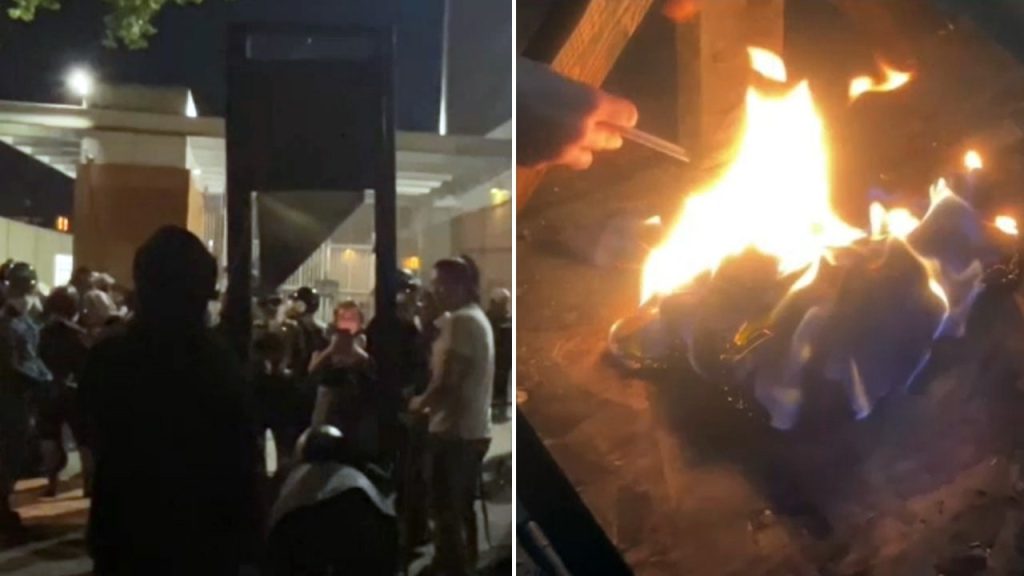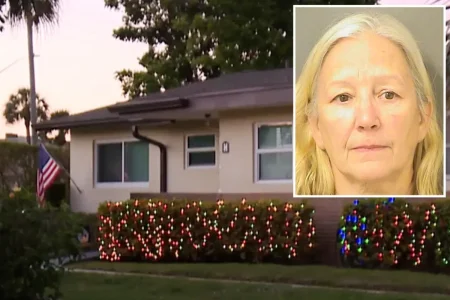ICE Condemns Portland Protesters’ Extreme Actions, Mayor Stands by Sanctuary City Status
In a disturbing display of civil unrest, protesters gathered outside the U.S. Immigration and Customs Enforcement (ICE) field office in Portland, Oregon on Labor Day, bringing with them a mock guillotine and burning a flag before engaging in violent confrontations with law enforcement. This extreme demonstration prompted a strong rebuke from ICE officials, who expressed deep concern over what they described as “unhinged behavior” targeting their officers. An ICE spokesperson emphasized to Fox News Digital that such inflammatory actions must cease, highlighting a troubling 1,000% increase in assaults against ICE officers who “put their lives on the line every day.” The spokesperson urged both political figures and activists to moderate their rhetoric, suggesting that extreme language and actions have contributed to an increasingly dangerous environment for immigration enforcement personnel.
The demonstration quickly escalated into chaos as local police attempted to clear the area, with footage capturing protesters using riot shields to protect themselves while hurling insults through loudspeakers at law enforcement officers, calling them “violent, cowardly pigs” and “sad excuses for human beings.” The confrontation represents yet another flare-up in the ongoing tensions surrounding immigration enforcement in Portland, a city that has experienced numerous protests on this issue in recent years. What makes this incident particularly alarming was the presence of the guillotine prop—a historically charged symbol of execution—which ICE officials interpreted as a direct threat against their personnel, further exacerbating concerns about officer safety in an already volatile climate.
Portland’s Mayor Keith Wilson, a Democrat, has doubled down on the city’s sanctuary status in response to the incident, clearly stating to local news outlet KOIN 6 that “We will not engage with the federal immigration enforcement that goes on.” Wilson affirmed that this position aligns with both the city’s sanctuary goals and the governor’s policies, assuring residents that Portland police would not collaborate with ICE “in any circumstances.” The mayor indicated he was working with local police to determine an appropriate response to the violent clashes, though his comments suggested limited interest in addressing the threats directed at federal officers, instead focusing on maintaining separation between local and federal enforcement actions.
ICE Deputy Director Madison Sheahan addressed the situation on “Fox & Friends,” acknowledging the “historic threats against ICE officers” but emphasizing that such intimidation would not deter the agency from its mission. Sheahan stated firmly that ICE would “continue to go after these criminals, these alien criminals that have wreaked havoc on the American people over the last four years,” while pledging ongoing support for ICE officers and their families. This support includes protection from doxxing—the public release of personal information—and other threats that officers reportedly face daily. The deputy director’s comments reflect the agency’s determination to maintain its enforcement priorities despite growing hostility and opposition in certain communities.
The Portland incident illuminates the deep divisions in American society regarding immigration enforcement. On one side stand federal authorities who maintain they are simply enforcing existing laws and protecting public safety by removing individuals with criminal backgrounds who are in the country illegally. On the opposing side are activists and local officials who view ICE operations as harmful to immigrant communities and contrary to their vision of a sanctuary city where residents can live without fear of deportation regardless of immigration status. This fundamental disagreement has repeatedly manifested in confrontational protests, with Portland becoming a frequent flashpoint due to its explicitly sanctuary-oriented policies and politically active population.
As tensions continue to simmer between federal immigration authorities and sanctuary jurisdictions like Portland, the incident raises serious questions about civil discourse and the boundaries of protest in a democratic society. While the right to demonstrate is constitutionally protected, the introduction of threatening symbols like guillotines potentially crosses the line into intimidation. Meanwhile, local and federal authorities remain at odds over jurisdiction and cooperation, creating a fractured enforcement landscape that satisfies neither side. Without meaningful dialogue and policy reform at the national level, these confrontations are likely to continue, placing both law enforcement officers and protesters at risk while doing little to address the underlying immigration challenges that have divided Americans for generations.








